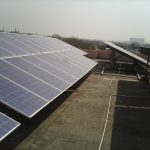Site I.9

Site ID
I.9
Health

COD
2017
Nominal Capacity
120 kWp
Average Specific Yield
800 kWh/kWp
Total Estimated Loss
13%
Possible Gain
5% to 8%
CAPEX, OPEX
0 ₹/Wp, 1.3 ₹/Wp/a
Expenditure / Energy
N/A
Abstract
The PV plant has a strong deviation towards SW that reduces significantly the amount of the solar resource. The irradiation on the module surface is also reduced by shading objects like trees. Modules with product defects such as unsealed frames and open junction boxes were detected. The modules are very hotspot sensitive. It is recommended to (i) increase the cleaning frequency to at least three times per month, (ii) increase the albedo using white gravel, (iii) replace modules with product defects, (iv) reduce the tilt angle by 2° and (iv) trim the trees in the South part. The estimated production boost caused by the retrofitting actions lies between 5% and 8%.
Main Findings
The PV modules have a strong orientation towards South-West (220°).
High presence of near shading objects and E-W shading caused by different mounting table heights.
A significant level of soiling was detected. The soiling is mainly caused by the presence of birds and nearby vegetation.
The irradiation sensor was installed at the wrong tilt and was significantly soiled.
The installed modules are very hotspot sensitive. The interrow shading leads to the development of hotspots at the lower module rows. The tree located South of the plant shades the PV surface created also hotspots. This was evidenced during the infrared inspection.
Impact on Performance
Heavy Soiling
Soiling measurements were conducted measuring both the short circuit current and nominal power before and after cleaning at irradiations close to 900W/m2.The estimated soiling factor is in the range of 6%.
Estimated Loss
≈ 6%
Deviation from South
The deviation of the PV plant towards South-East leads to an irradiation loss towards the optimum of around 7%.
Estimated Loss
≈ 7%
Total Estimated Energy Loss
≈ 13%
Proposed Solutions
The cleaning cycles shall be increased and defined based on a soiling study that adjusts the cleaning needs to each season. Cleaning once a month during the dry season is not enough.
The tree in the south-east corner should be trimmed
The irradiation sensor shall be cleaned and installed at the correct tilt.
Increasing the albedo from 0.2 to 0.5 by covering the ground with white gravel leads to an increase of the irradiation on tilted surface of at least 1.3%.












